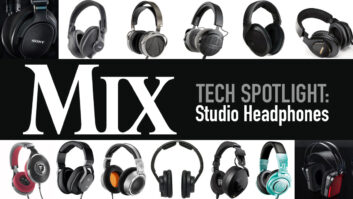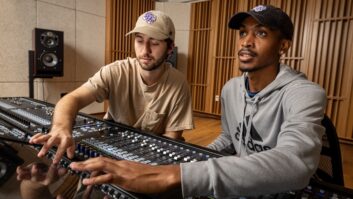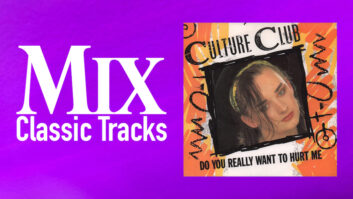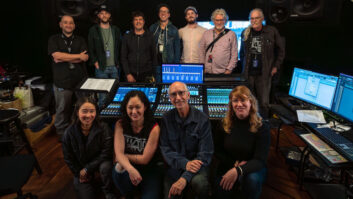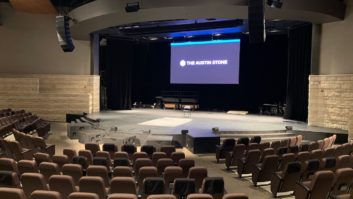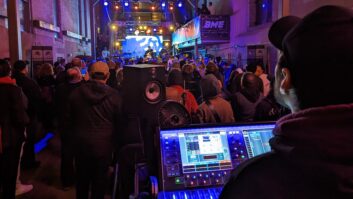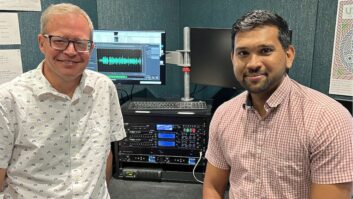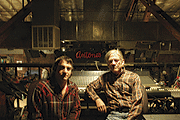
With more live venues per capita than most musical hotbeds, Austin has become a go-to stop for many national traveling acts, while nurturing the careers of homegrown musicians. In fact, on August 29, 1991, the Austin City Council voted in favor of making Austin’s official slogan to be “Live Music Capital of the World” — a political compromise as the original suggestion was “Live Music Capital of the Universe.” The city boasts a $600 million music industry — including recording studios, musical acts, instrument makers and record labels — with the annual showcase-packed South By Southwest music convention indubitably helping to boost that figure. In honor of SXSW, Mix checks in with some of Austin’s live music venues.
Head of audio John “Hazmat” Haddad (left) with engineer Steve Goteskey
photo: Casey Carter
ANTONE’S
Founded in 1987 by Clifford Antone, recipient of The National Blues Foundation’s Lifetime Achievement Award, Antone’s opened its doors with performances by zydeco king Clifton Chenier and piano legend Sunnyland Slim, to be followed during the years by such musical titans as B.B. King, Fats Domino, John Lee Hooker and the late Muddy Waters, as well as showcasing then up-and-comers such as Stevie Ray Vaughan and the Fabulous Thunderbirds (who for years served as the house band). Also in ’87, Antone launched Antone’s Records, which offers live recordings from the venue, including the 1988 release James Cotton Live at Antone’s, which earned the label its first Grammy nomination. Direct Events purchased the venue in 1993 (it also owns Austin Music Hall, The Backyard and La Zona Rosa), and Antone’s continues to be known as Austin’s “Home of the Blues.” A Soundcraft 40-channel Series 2 board is situated at front of house, with outboard gear from dbx, Behringer, Yamaha, Roland, Boss and Ashly. Amplification is via Crown Macro-Tech with JBL subs. Monitor world houses a Soundcraft Spirit 32-channel board with a built-in split with six channels of Behringer EQ. Onstage are six EAW 159z full-range wedges (no sidefills), two Yamaha CP2000 monitors amps and a QSC MX200A amp.

Engineer Jimmy Stickle at Austin Music Hall’s FOH position
photo: Barbara Dicely
AUSTIN MUSIC HALL
The city’s premier mid-sized venue (3,000 capacity), the Austin Music Hall hosts concerts and special events (film premiere post-parties, the Armadillo Christmas Bazaar, etc.). A former warehouse, the building was given an art deco makeover by owners Direct Events, and now brings in national touring acts and local country, folk and rock music talent, including recent visitors such as Bob Dylan, Eric Clapton, Sheryl Crow, the Allman Brothers, Chris Isaak, Natalie Merchant and many more. A locally rented P.A. (from either Miller Pro Audio or Big House Sound) can be flown or stacked, with a max load of 16,000 pounds. The venue caters to incoming engineers’ audio tech riders, as much of the hall’s gear is rented.

Hot Snakes performing at Emo’s
photo: Aubrey Edwards
EMO’S
Sporting two stages (one small stage inside and a large, partially covered outside stage; both can run simultaneously), Emo’s opened in the early 1990s by, well, Emo. The club has seen its fair share of major touring acts, including Johnny Cash back in 1994 — patrons can see his old barstool hanging from the ceiling. Other notables appearing at Emo’s include the White Stripes, The Donnas and Mighty Mighty Bosstones, as well as many other alternative, punk, grunge and thrash bands. The outside stage’s front of house is stacked with an Allen & Heath GL 3300 console. Amps are QSC PL 230 and PLX 2402, Crest 6001 and Peavey 1200. Outboard gear comprises dbx gates and compressors, a Yamaha REV-5 and a Lexicon MPX-550. JBL speakers are in all cabs. Monitor world hosts another GL 3300 board and is rounded out by three QSC PL 230s, Crown Macro-Tech 2400, Peavey CS100 paired with a Micro-Tech 1200, four Peavey EQ27s and a dbx 2231 EQ. Emo’s mic closet is stocked with models from Shure and Electro-Voice, with Behringer and Whirlwind DIs. Indoors, a Soundcraft Spirit 8 is situated at FOH, with much of the same gear as the outside stage. Monitors are fed from two aux sends on the main board; again, much of the same gear as listed for the outside stage is also indoors.

Lucky Dube and band jammin’ out at Flamingo Cantina
FLAMINGO CANTINA
Bringing the sounds of the West Indies to Austin’s Sixth Street entertainment district, the 300-capacity, partially open Flamingo Cantino houses two 32-channel Allen & Heath GL2200-432 boards (one at FOH, one at monitors). Front of house is situated 30 feet from the dance floor and features dbx gate/comp/EQ/limiters, Behringer gates, two Yamaha SPX-90 II units and two Roland SDE-1000s. The venue’s FOH speaker array comprises six 18-inch MA-5002 subs, two 2×15-inch mid-bass MA-3600 cabs, two 2×12 mid-high MA-3600 cabs and two 2-inch horn-loaded HF MA-602 compression drivers; all speakers are powered by Crown Macro-Tech amps with processing carried out by two dbx DriveRack 240 units. The monitor board allows for six independent mixes heard through six 15-inch wedges and a 2×15-inch drum monitor; no sidefills or overheads are used. Monitor speakers comprise models from JBL and Peavey driven by Micro-Tech amps; all monitors are bi-amped with Furman crossovers. A limited backline is available upon request.

Interpol at Stubb’s
photo: Cambria Harkey
STUBB’S
Bringing together good food and good music, Stubb (born Christopher B. Stubblefield) opened his first barbecue joint after serving a tour of duty in the Korean War, where he became a self-styled DJ by playing music over the field radio. When his tour was over, Stubb returned to Lubbock, Texas, and opened his first restaurant in the 1970s. Alongside world-class barbecue, Stubb’s became ground zero for musicians such as Joe Ely, Jimmie Dale Gilmore and Stevie Ray Vaughan, who played “for their supper.” Stubb moved his restaurant/club to Austin, taking residence in numerous spots before settling down at his current location in 1996 to serve up live music 300 days a year. For the indoor room (all gear is rented from Big House Sound for the outdoor room), visiting FOH engineers can use a Soundcraft 32-channel Series 2 (eight aux buses) with Lexicon, TC Electronic, Drawmer, dbx and Behringer outboard gear. Mains comprise four custom JBL 12-inch mid/highs with a 2-inch driver (flown two per side) and three Yamaha subs with JBL 15-inch speakers (situated understage). Four monitor mixes (taken from the house console) are offered with DOD EQs and seven Adamson Mxi Compact wedges. The venue’s mic closet offers Shure SM58/57/Beta 52/BG 4.0, Sennheiser 604s, Audio-Technica ATM-29HEs and four DI boxes.

Head of audio John “Hazmat” Haddad and engineer Cassie Brocket (left)
photo: Casey Carter
LA ZONA ROSA
Formerly a Mexican restaurant, La Zona Rosa, located in Austin’s warehouse district, hosts musical acts from Western to alternative rock, including appearances by the Flaming Lips, Primal Scream, Guided By Voices, Mogwai and Stereolab. A 900-capacity room sees benefits and festivals, while the second room — a 1,200-capacity area with an arched, open-air roof — hosts larger acts. A Soundcraft Series Four 40×4 board occupies front of house with BSS EQ, Drawmer compressor/gates, Yamaha SPX-990, TC Electronic delay and Adamson three-way processors. Power is via Crown Macro-Tech amps and six dual 18-inch JBL subs. Over at monitor world is a Yamaha MC3210 (offering eight onstage mixes) with EAW bi-amped wedges and tri-amped drum subs (no sidefills), and dbx 31-band EQ. The venue also provides an assortment of Shure mics, cables and stands.

